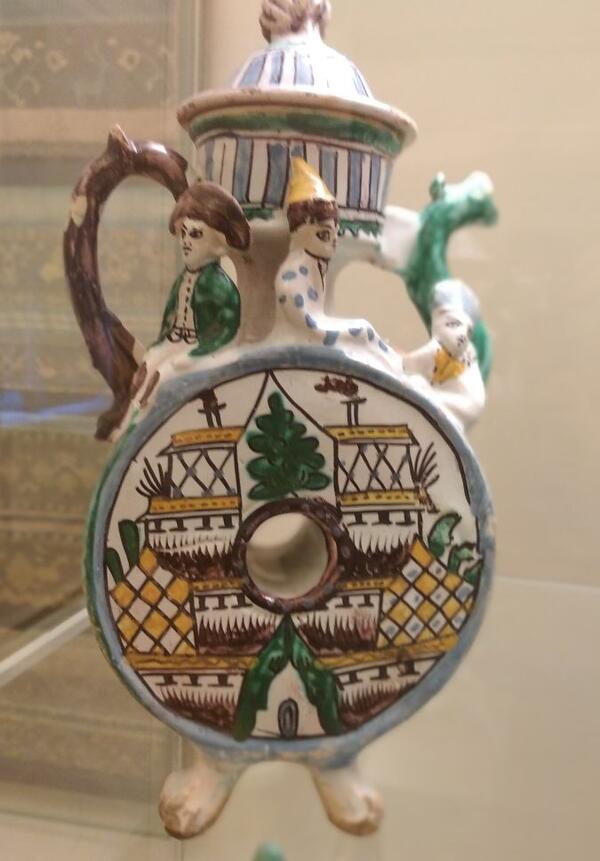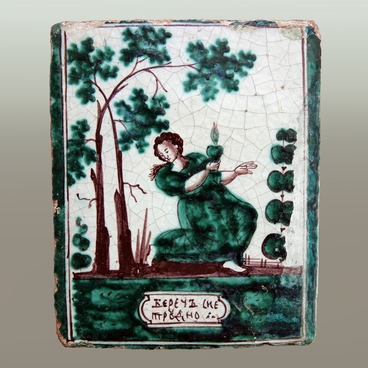A kvas jug is a vessel used to store and serve different types of kvas. The presented kvas jug is made in the technique of majolica — a richly-colored pottery ornamented with paints, which came to Russia from Western Europe. The forms of Gzhel kvas jugs and kumgans (kvas jugs differ from kumgans in that they have a hole in the center) follow the tradition of the 17th century, but their decor is unique.
The decor of the vessel combines sculptural and pictorial techniques: there are figurines on the vessel’s shoulders and painted images on the side disks. The kvas jug features the figurines of a woman in a kokoshnik, a man in a pointed hat, and a military man in a cocked hat. The picturesque architectural landscape is arranged in tiers. Perhaps these are the images of Gzhel ceramic factories with their smoking chimneys.
The pottery district of Gzhel was the most famous center of Russian ceramics, uniting about 30 villages in the Bogoroditsky and Bronnitsky uezds of the Moscow Governorate. The craft started with the production of peasant household utensils and clay toys. In the second half of the 18th century, local craftsmen started manufacturing majolica, which was replaced by semi-faience and porcelain in the 19th century. The heyday of majolica production was in the 1770s–1780s. Gzhel potters opened about 25 small workshops that made majolica products. Their highest achievement was producing kumgans and kvas for festive occasions. Artisans found an ideal shape that was both practical and beautiful. In 1824, the first Russian ceramic factory was founded by Afanasy Grebenshchikov in Moscow.
Painted images resembled popular prints. The paint had to be applied to the opaque glaze in a quick and accurate way. The dark contour of the picture was colored in green, yellow, or blue. Genre scenes and architectural landscapes were depicted on the disk of the vessel. The decorative painting of kumgans and kvas jugs was a magnificent example of accurate, ornamental underglaze painting.
Gzhel kumgans and kvas jugs have become a unique phenomenon in the history of art. Folk ceramics of other cultures did not use such a synthesis of form, painting and sculpture.
The decor of the vessel combines sculptural and pictorial techniques: there are figurines on the vessel’s shoulders and painted images on the side disks. The kvas jug features the figurines of a woman in a kokoshnik, a man in a pointed hat, and a military man in a cocked hat. The picturesque architectural landscape is arranged in tiers. Perhaps these are the images of Gzhel ceramic factories with their smoking chimneys.
The pottery district of Gzhel was the most famous center of Russian ceramics, uniting about 30 villages in the Bogoroditsky and Bronnitsky uezds of the Moscow Governorate. The craft started with the production of peasant household utensils and clay toys. In the second half of the 18th century, local craftsmen started manufacturing majolica, which was replaced by semi-faience and porcelain in the 19th century. The heyday of majolica production was in the 1770s–1780s. Gzhel potters opened about 25 small workshops that made majolica products. Their highest achievement was producing kumgans and kvas for festive occasions. Artisans found an ideal shape that was both practical and beautiful. In 1824, the first Russian ceramic factory was founded by Afanasy Grebenshchikov in Moscow.
Painted images resembled popular prints. The paint had to be applied to the opaque glaze in a quick and accurate way. The dark contour of the picture was colored in green, yellow, or blue. Genre scenes and architectural landscapes were depicted on the disk of the vessel. The decorative painting of kumgans and kvas jugs was a magnificent example of accurate, ornamental underglaze painting.
Gzhel kumgans and kvas jugs have become a unique phenomenon in the history of art. Folk ceramics of other cultures did not use such a synthesis of form, painting and sculpture.



